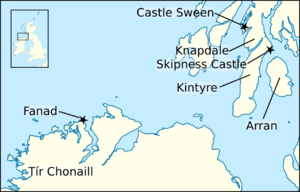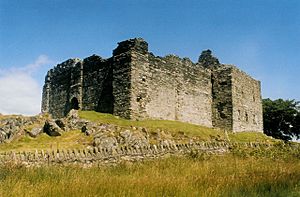Eóin Mac Suibhne facts for kids
Quick facts for kids
Eóin Mac Suibhne
|
|
|---|---|

Eóin's name as it appears on page 264 of National Library of Scotland Advocates MS 72.1.37 (the Book of the Dean of Lismore): "One m'soyne".
|
|
| Noble family | Clann Suibhne |
| Father | Suibhne Mac Suibhne |
Eóin Mac Suibhne was a Scottish nobleman who lived in the 1300s. He was an important leader of the Clann Suibhne family. Around the 1260s, Eóin's family was forced out of their home in Argyll, Scotland, by another powerful family called the Stewarts/Menteiths. This might be when some of Clann Suibhne moved to Ireland.
In the early 1300s, Eóin tried to get his family's Scottish lands back. He supported the English during the First War of Scottish Independence. This was a way to fight against the Stewarts/Menteiths, who were on the Scottish side. An old Gaelic poem might even be about Eóin's journey to reclaim his family's land. While some later stories say Eóin was the first Clann Suibhne leader in Fanad, Ireland, older records suggest the family gained that leadership later in the 1300s.
| Top - 0-9 A B C D E F G H I J K L M N O P Q R S T U V W X Y Z |
Who Was Eóin Mac Suibhne?
| Simplified pedigree of the Clann Suibhne illustrating Eóin's place in the kindred. | ||||||||||||||||||||||||||||||||||||||||||||||||||||||||||||||||||||||||||||||||||||||||||||||||||||||||||||||||||||||||||||||||||||||||||||||||||||||||||||||||||||||||||||||||||||||||||||||||||||||||||||||||||||||||||||||||||||||||||||||||||||||||||||||||||||||||||||||||||||||||||||||||||||||||||||||||||||||||||||||||||||||||||||||||||||||||||||||||||||||||||||||||||||||||||||||||||||||||||||||
|---|---|---|---|---|---|---|---|---|---|---|---|---|---|---|---|---|---|---|---|---|---|---|---|---|---|---|---|---|---|---|---|---|---|---|---|---|---|---|---|---|---|---|---|---|---|---|---|---|---|---|---|---|---|---|---|---|---|---|---|---|---|---|---|---|---|---|---|---|---|---|---|---|---|---|---|---|---|---|---|---|---|---|---|---|---|---|---|---|---|---|---|---|---|---|---|---|---|---|---|---|---|---|---|---|---|---|---|---|---|---|---|---|---|---|---|---|---|---|---|---|---|---|---|---|---|---|---|---|---|---|---|---|---|---|---|---|---|---|---|---|---|---|---|---|---|---|---|---|---|---|---|---|---|---|---|---|---|---|---|---|---|---|---|---|---|---|---|---|---|---|---|---|---|---|---|---|---|---|---|---|---|---|---|---|---|---|---|---|---|---|---|---|---|---|---|---|---|---|---|---|---|---|---|---|---|---|---|---|---|---|---|---|---|---|---|---|---|---|---|---|---|---|---|---|---|---|---|---|---|---|---|---|---|---|---|---|---|---|---|---|---|---|---|---|---|---|---|---|---|---|---|---|---|---|---|---|---|---|---|---|---|---|---|---|---|---|---|---|---|---|---|---|---|---|---|---|---|---|---|---|---|---|---|---|---|---|---|---|---|---|---|---|---|---|---|---|---|---|---|---|---|---|---|---|---|---|---|---|---|---|---|---|---|---|---|---|---|---|---|---|---|---|---|---|---|---|---|---|---|---|---|---|---|---|---|---|---|---|---|---|---|---|---|---|---|---|---|---|---|---|---|---|---|---|---|---|---|---|---|---|---|---|---|---|---|---|---|---|---|---|---|---|---|---|---|---|---|---|---|---|---|---|---|---|---|---|---|---|---|---|---|---|---|---|---|---|---|---|
|
||||||||||||||||||||||||||||||||||||||||||||||||||||||||||||||||||||||||||||||||||||||||||||||||||||||||||||||||||||||||||||||||||||||||||||||||||||||||||||||||||||||||||||||||||||||||||||||||||||||||||||||||||||||||||||||||||||||||||||||||||||||||||||||||||||||||||||||||||||||||||||||||||||||||||||||||||||||||||||||||||||||||||||||||||||||||||||||||||||||||||||||||||||||||||||||||||||||||||||||
Eóin was part of Clann Suibhne, a family that came from a leader named Suibhne mac Duinn Shléibhe. Eóin's father was also named Suibhne. His grandfather was Maol Mhuire an Sparáin, who was the son of Murchadh Mac Suibhne.
Around the mid-1200s, Eóin's family was likely forced out of their home in Argyll. The Stewarts/Menteiths took over their land. This is probably when Clann Suibhne moved to Ireland. They started working as gallowglass warriors there. Gallowglasses were a special type of heavily armed soldier. Eóin's great-grandfather, Murchadh Mac Suibhne, died in Ireland in 1267 while held prisoner by the Earl of Ulster.
As late as 1261, an earlier family member, Dubhghall mac Suibhne, was the lord of Skipness Castle. That year, Dubhghall gave some of his land to Paisley Abbey. The next year, he reportedly gave Skipness and other lands to Walter Stewart, Earl of Menteith.
We don't know exactly why Dubhghall gave up his lands. It's possible his family was defeated in a fight. The Stewarts/Menteiths taking over Knapdale likely helped the Scottish king gain more control in Argyll. Later, Clann Suibhne still felt this land arrangement was wrong.
Fighting for the English in 1310
Eóin might be the subject of an old Gaelic poem called Dál chabhlaigh ar Chaistéal Suibhne. This poem describes a sea attack on Castle Sween and the area around it, called Knapdale, from Ireland. The poem might be about a real attack, or it could just be an imagined, grand expedition that never happened. Some think the poem was written for a different family member, Eóghan, who was a leader in Fanad. In that case, it would be about Eóghan's plan to get his family's Scottish land back.
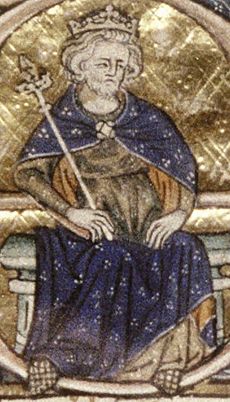
In February 1306, Robert Bruce VII, Earl of Carrick, who wanted to be King of Scotland, killed his main rival, John Comyn. Robert became King Robert I in March, but the English king fought back. Robert was defeated and became a fugitive. By 1309, Robert had largely won against his enemies and held his first parliament as king.
In 1310, King Edward II of England sent an army into Scotland. Part of this army was a naval force from Ireland, led by Richard de Burgh, Earl of Ulster. Richard might have been meant to help the English-allied Clann Dubhghaill in Argyll. It's likely that the English king contacted Eóin and other powerful leaders to help with this campaign.
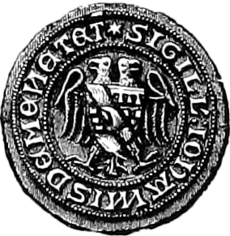
In July 1310, letters between Eóin and Edward II show that the English king gave Eóin and his brothers, Toirdhealbhach and Murchadh, the land of Knapdale. This land used to belong to their ancestors. Edward II gave it to them so they could fight against John Menteith, who supported the Scottish king. Eóin's family supported the English because John Menteith and the Stewarts were their old enemies. This shows how local rivalries affected who people supported in the war.
More letters confirm this royal gift to Eóin. They also show that Eóin was with Aonghus Óg Mac Domhnaill and Hugh Bisset while fighting John. Eóin wrote to the king saying that he visited Knapdale but couldn't take it because Eóin Mac Dubhghaill's forces were there. A few weeks later, Edward II sent the fleet to Mann instead.
If the poem Dál chabhlaigh ar Chaistéal Suibhne is about a real event, it might have happened around the time Edward II made this offer to Eóin. However, Clann Suibhne was never able to get Knapdale back. The fact that the naval campaign didn't happen as planned might explain why Eóin couldn't secure his family's lands. After this failure, Eóin seems to have served in Ireland. Later, Clann Suibhne members became military commanders there.
Some old stories say Eóin was banished from Scotland after killing a man. Then he moved to Ireland and became the first Clann Suibhne lord of Fanad. But there's reason to believe this isn't true. For example, Irish records don't mention this event. Also, other records show that Clann Suibhne was given land in Fanad later in the 1300s, suggesting they didn't own the whole area yet. The first recorded Clann Suibhne Lord of Fanad was Toirdhealbhach Caoch.
Losing the Family's Land for Good
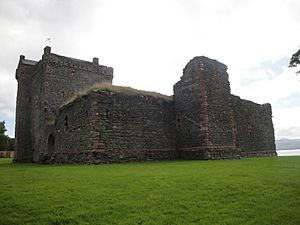
In 1314, Edward II gave the lands of Knapdale and Glendaruel to one of his Scottish supporters, Dungal de Gyvelestone. These lands were said to be held by John Menteith, and earlier by someone named "Suny Magurke." This "Suny" might have been Eóin's father, or another family member.
After Robert the Bruce became king and took control of Scotland, he took land from those who supported the English. He gave it to his own supporters. The large territories of Clann Dubhghaill were broken up. As for Clann Suibhne's former land in Knapdale, Robert apparently gave it to John Menteith. John's grandson was later called "Lord of Knapdale and Arran" in 1357. He gave some lands, including Castle Sween, to Giolla Easbuig Caimbéal.
Clann Suibhne's Ties to the Uí Domhnaill Family
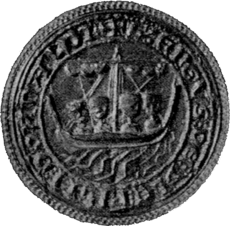
Domhnall Óg Ó Domhnaill, King of Tír Chonaill, was connected to Clann Suibhne through marriage. Old family records say that a daughter of a Mac Suibhne was the mother of Domhnall Óg's son, Aodh. Domhnall Óg himself was raised by Clann Suibhne, as shown in a poem from that time. Aodh became king in 1281. His mother was likely born around 1250, so she probably wasn't Eóin's daughter. However, some stories claim Eóin was Aodh's grandfather through a daughter named Caiteríona.
In September 1286, some Scottish and Anglo-Irish leaders made an agreement called the Turnberry Band. They promised to support each other. Three of the signers were from the Stewart/Menteith family: Walter and his two sons, Alexander and John. Their involvement might have been about their family taking over Clann Suibhne's land in Argyll.
Clann Suibhne, forced from their home, found a safe place in Tír Chonaill, Ireland, because of their marriage ties to Domhnall Óg. Another signer of the agreement was Richard, whose father had held Murchadh Mac Suibhne prisoner. It's possible that the Stewarts/Menteiths were worried about Clann Suibhne, now in Tír Chonaill and supported by Aodh. The Earl of Ulster's role in Murchadh Mac Suibhne's death might also mean his family was against Clann Suibhne settling in Ireland.
Two other signers were Aonghus Mór mac Domhnaill, Lord of Islay, and his son, Alasdair Óg. They were important leaders of Clann Domhnaill. Aonghus Mór's daughter was married to Domhnall Óg and was the mother of his son, Toirdhealbhach. So, Aonghus Mór and Alasdair Óg might have signed the agreement to help Toirdhealbhach become King of Tír Chonaill. Toirdhealbhach was related to Clann Domhnaill through his mother. This was against his half-brother, Aodh, who was related to Clann Suibhne.
In 1290, old Irish records say that Aodh was defeated by his half-brother, Toirdhealbhach, who then became king with the help of Clann Domhnaill. We don't know if this fight was a direct result of the agreement, but it seems likely that Aonghus Mór's part in the pact was about the military power of his family. When Toirdhealbhach was defeated again in 1295, he had to leave Tír Chonaill and found safety with other families, including Clann Domhnaill. The fights between the half-brothers and their allies continued until Toirdhealbhach was defeated and died in 1303.
The Clann Suibhne gallowglass warriors who supported Aodh might have been led by Eóin. It's possible that Clann Suibhne launched their attacks against the Stewarts/Menteiths from Tír Chonaill, with Aodh's support. The history of Clann Suibhne in the 1200s and 1300s shows how powerful their leaders were. It also shows their ability to stay strong even without a fixed home territory.
Images for kids
-
The effigy of Walter Stewart, Earl of Menteith and his wife, Mary I, Countess of Menteith.


